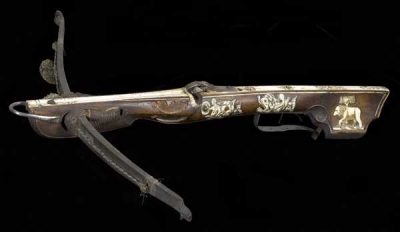Steel trigger crossbow (1884.16.12)
 GermanySteel trigger crossbow from Germany, Europe. Part of the Pitt Rivers Museum Founding Collection. Given to the Museum in 1884.
GermanySteel trigger crossbow from Germany, Europe. Part of the Pitt Rivers Museum Founding Collection. Given to the Museum in 1884.
This steel-lathed German crossbow is of a type used between 1450 and 1800 across an area spreading outwards from Nuremburg and Augsburg in Bavaria. There were two sizes of this type of bow and this example is of the smaller kind. Accordingly, it was known as a 'half-sized bow' or Halberüstung. However, it still had a large draw weight of 700 pounds (320 kilograms). This was far too much to be drawn by hand it was done using a separate, toothed ratchet-type machine that was attached to the stock.
The Art of War
Such bows were too laborious to span (draw), too fiddly to set the sights on, and too richly ornamented, to be anything other than the sporting bows of wealthy gentlemen.
In around 1540, two major stylistic changes took place in Halberüstung design. Firstly, the long shallow butt of earlier forms was replaced with a short, high butt, i.e. more like that of a modern rifle. Secondly, one side of the butt was hollowed out to permit the archer to place his cheekbone against the stock, and sight along the line of the bolt. This example has the earlier form of butt but also the hollowed section, combining both early and late features on one weapon. It therefore represents an intermediate form and can be attributed a late-16th century date.
However, among the older ivory inlay, there are depictions along a marine theme of tritons, mermaids and fishes, as well as bears and so on. This is characteristic of the Louis XIV style (1638-1715), preceding and ancestral to the Rococo. Indeed, an ivory plaque bearing the date 1676 has been added to the butt. Perhaps this was done by a later owner who wished to authenticate its age but if that is the case, he or she seriously underestimated it, not realising the structure predated the decoration by 150 years.





